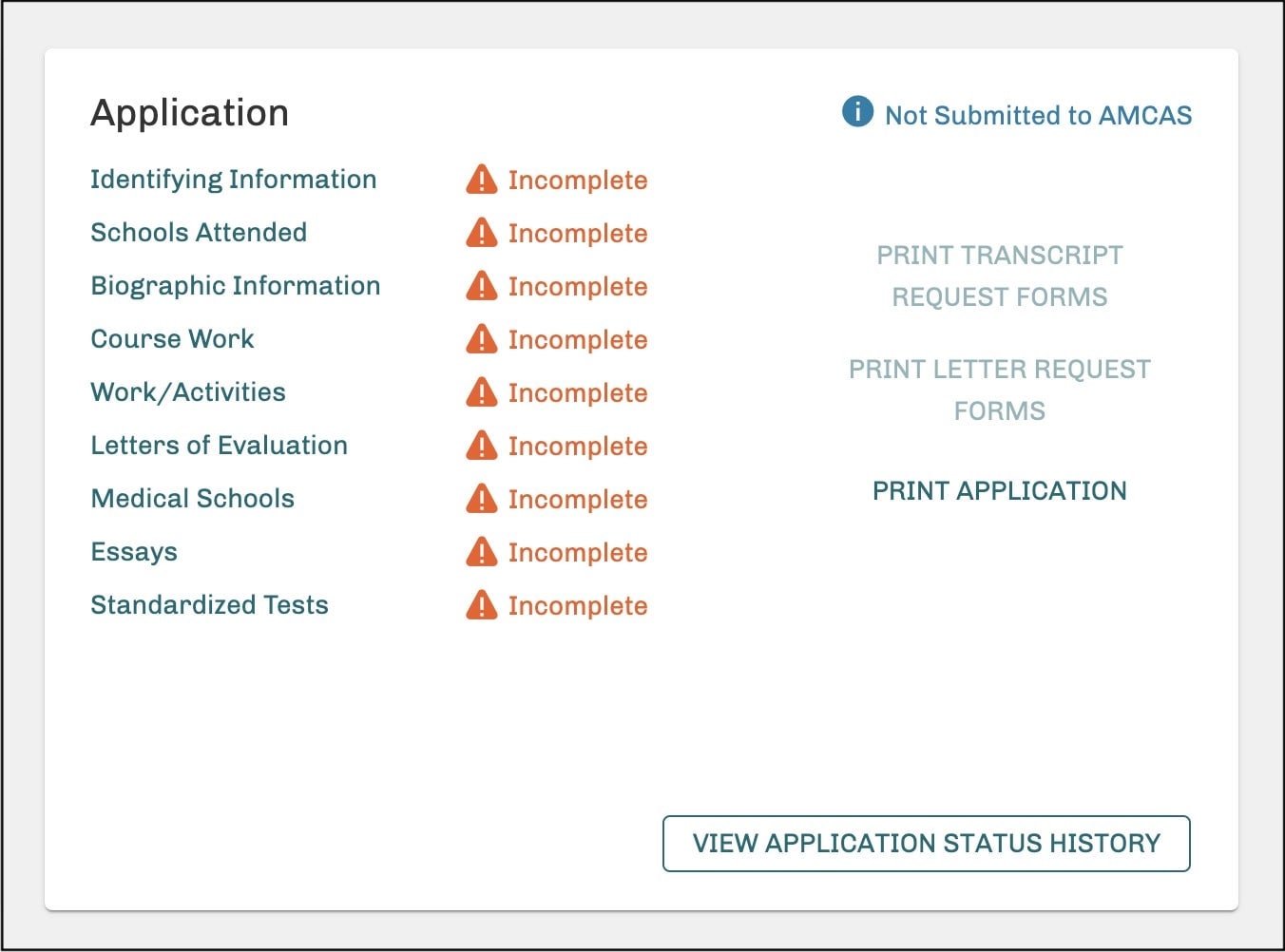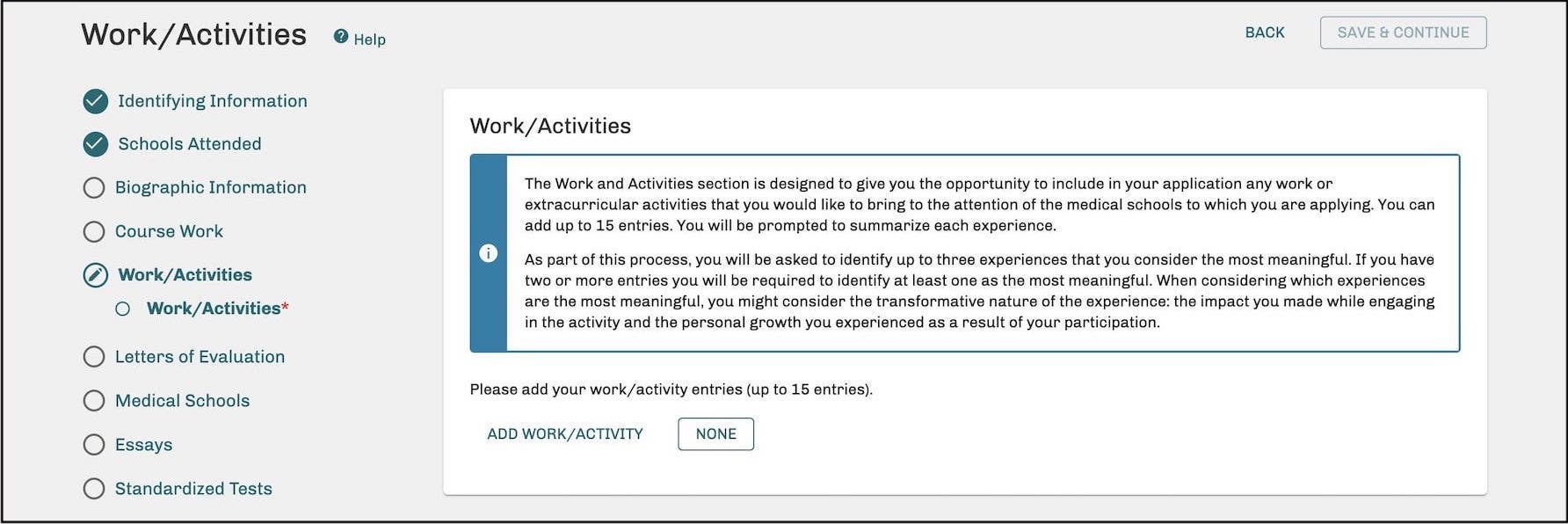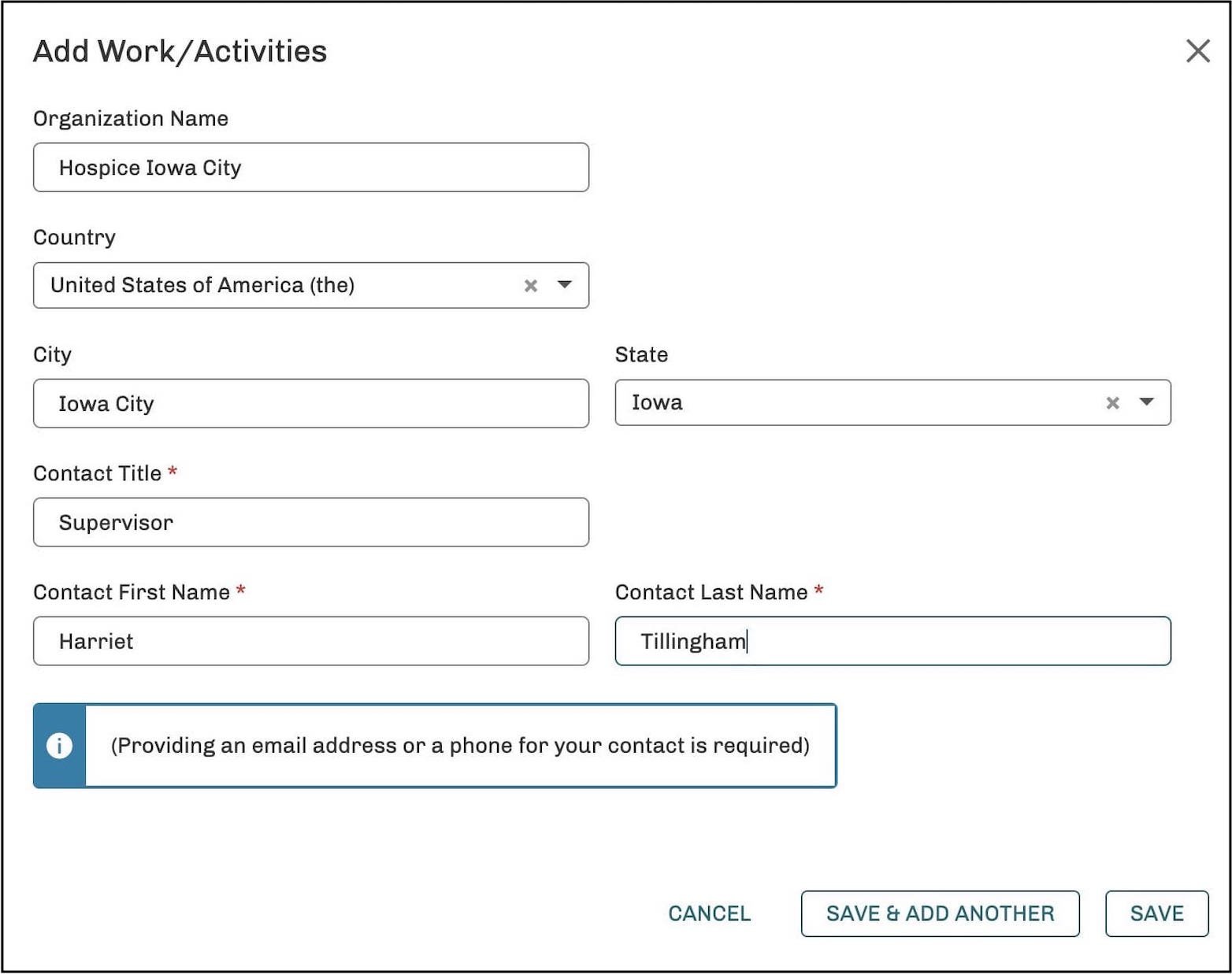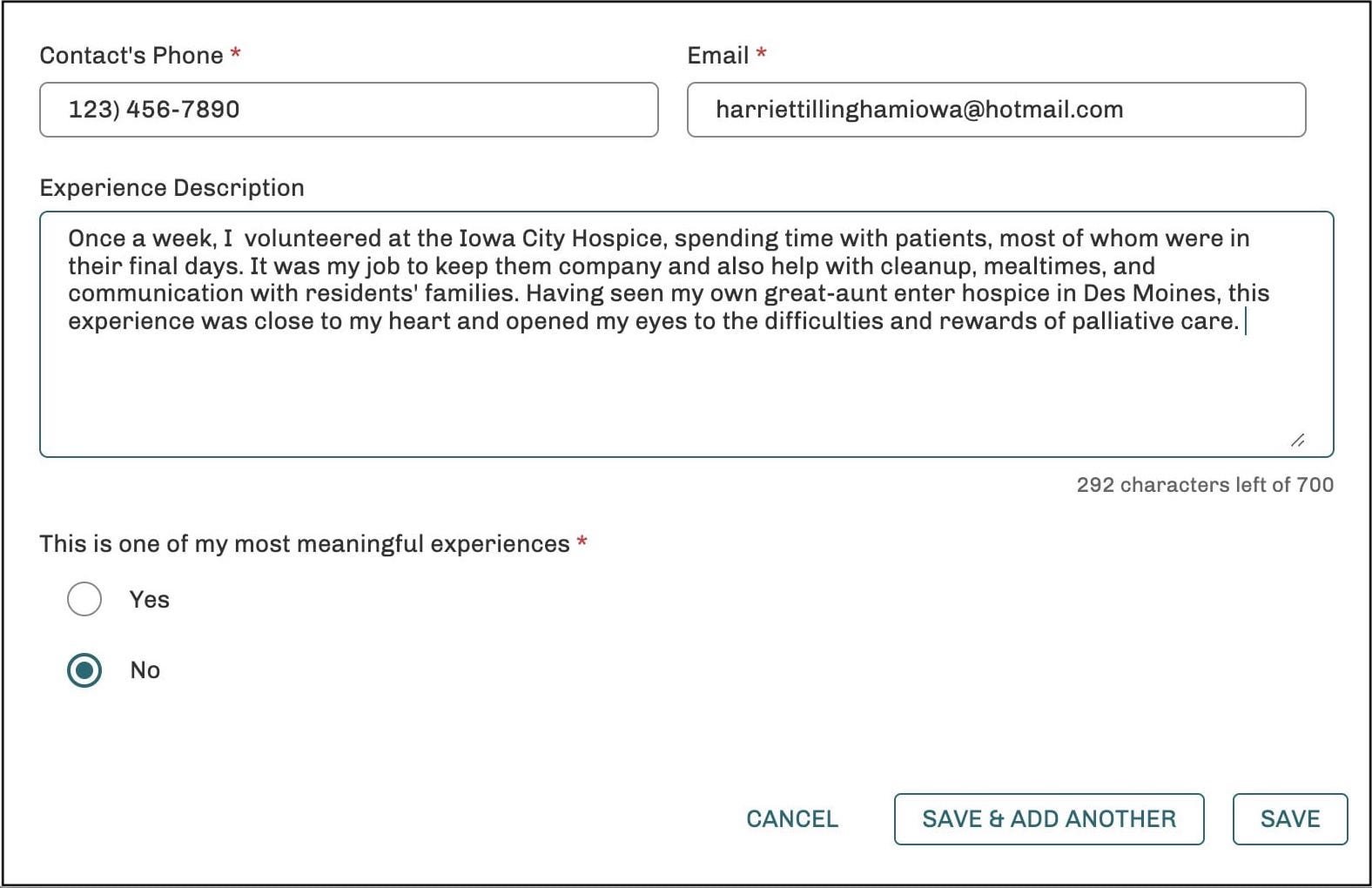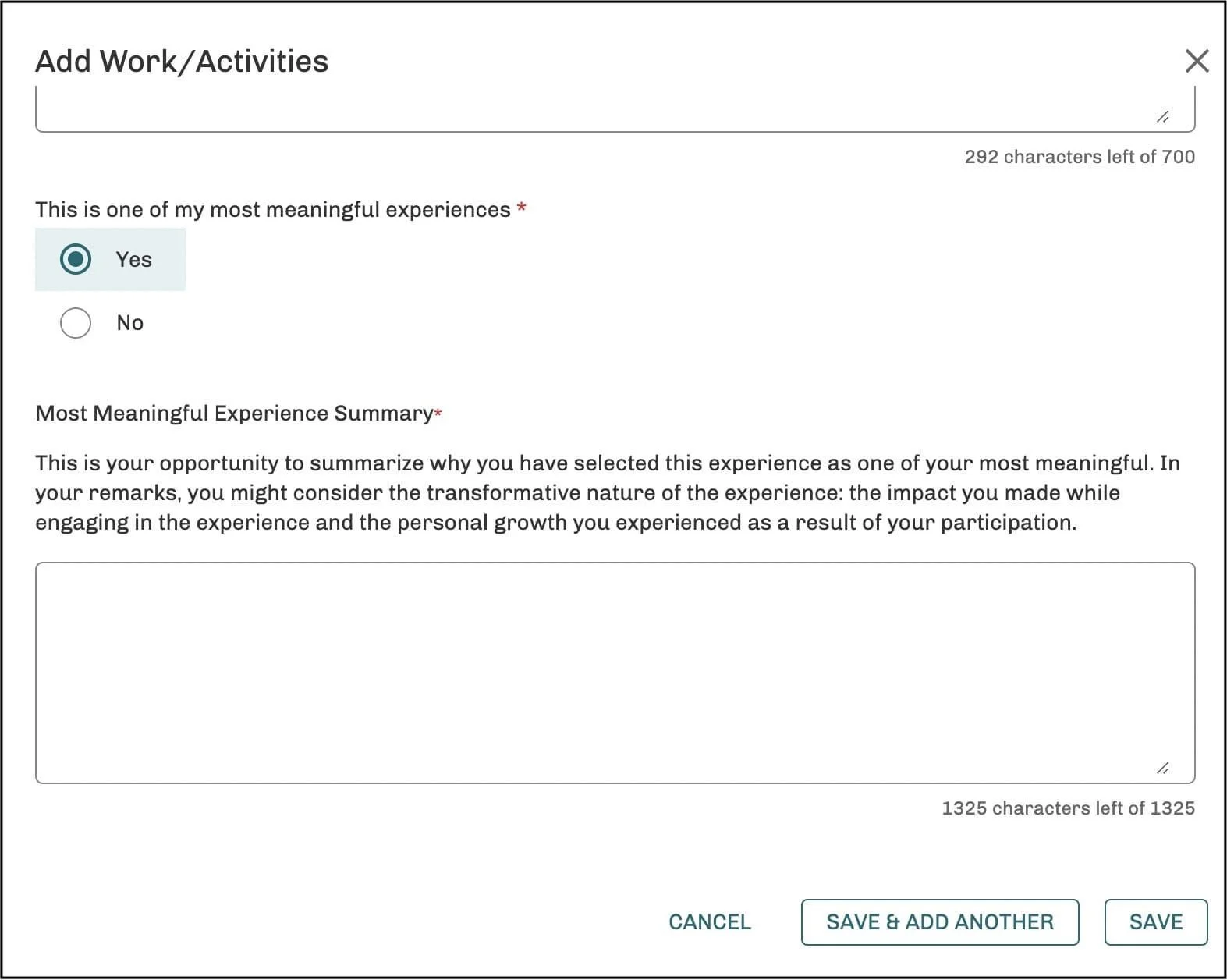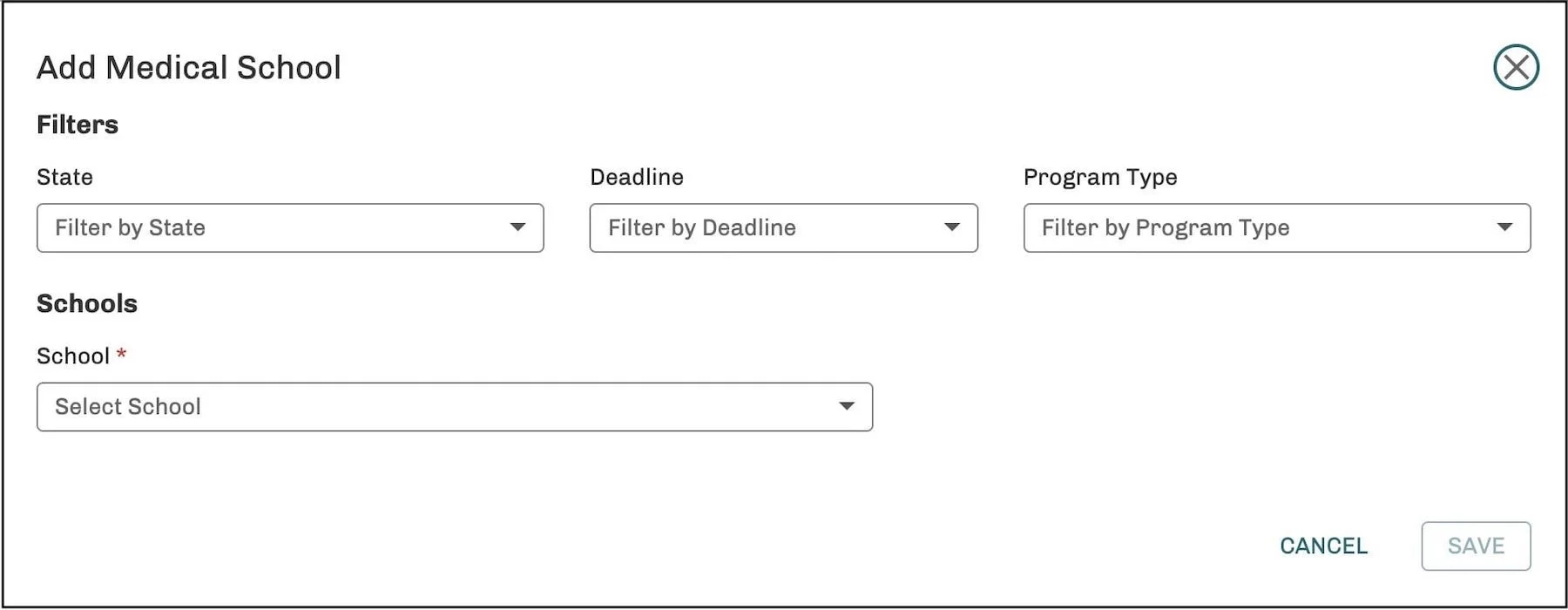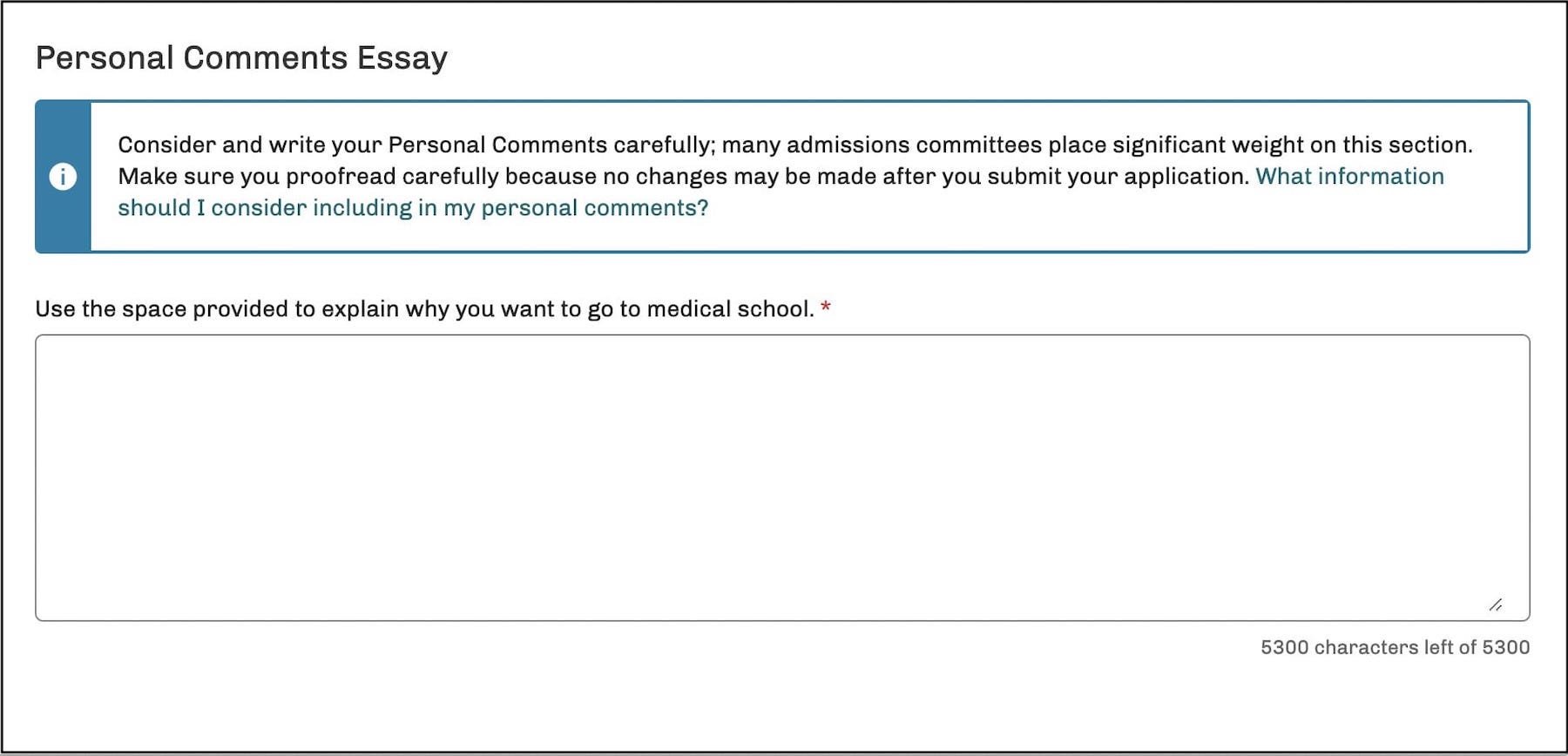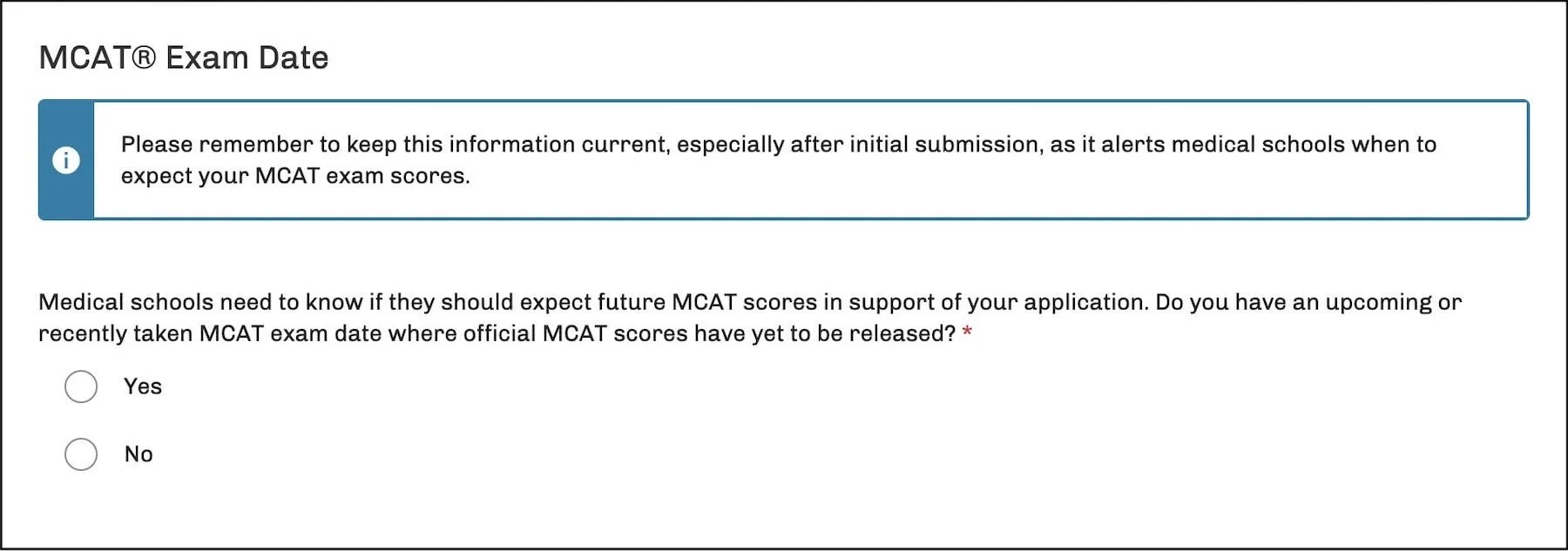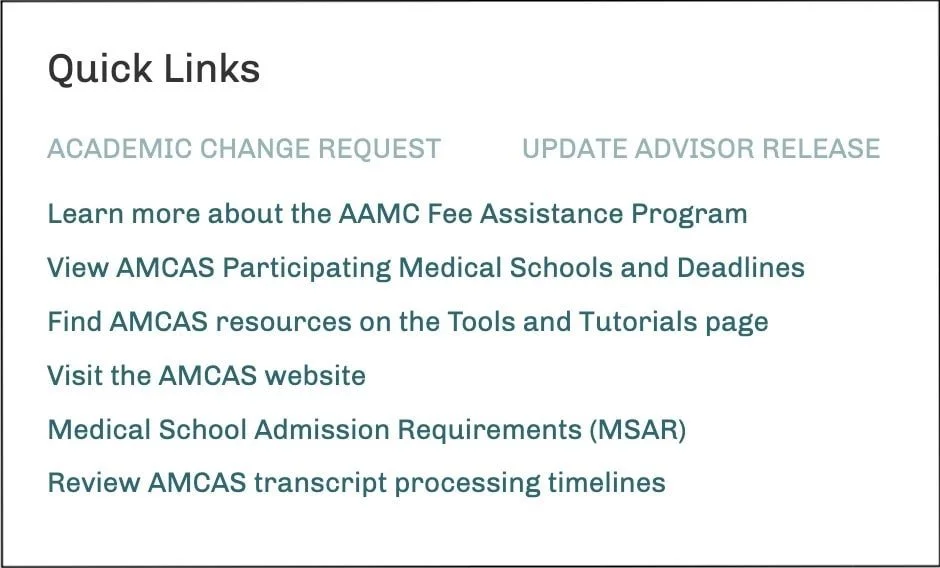AMCAS Application: The Ultimate Guide (2025)
/A step-by-step guide to completing the AMCAS application for medical school
the amcas application is used by most allopathic medical schools in the us
What is the AMCAS application?
If you’re applying to medical school for the first time, you’ve likely heard of AMCAS, the American Medical College Application Service.
Run by the Association of American Medical Colleges, the AMCAS medical school application is a centralized application service through which you’ll submit your grades, MCAT scores, descriptions of your work experience and extracurricular activities, your AMCAS personal statement, and AMCAS letters of recommendation. The AMCAS is basically the Common Application for MD programs.
AMCAS is used widely by U.S. allopathic medical schools, so it’s necessary to understand how it works and how to fill it out correctly. It can be a confusing system to navigate, so we’ve broken it down into its tiniest components in this comprehensive AMCAS application guide. Below, we’ll walk you through each step of the process so you can be sure to get it right.
What to know before getting started
Before you sit down to work on your AMCAS application, it’s helpful to familiarize yourself with a few particulars regarding deadlines and what happens after it’s been submitted.
While AMCAS is a centralized application system, the deadlines for submission will vary by medical school. Be sure to check with each school you intend to apply to and make a list of when they need to receive your AMCAS application as well as when they need to receive your official transcripts.
AMCAS states that in order to meet a school’s deadline, application materials must be received by 11:59pm EST on the deadline date. If you are participating in the early decision program, that deadline is August 1st.
Application processing
After you have submitted your application, it can take six to eight weeks for verification to complete. This is especially true during peak season, which AMCAS states is June to September. Try to be patient! We know that after sending in your application, you’ll be anxious for things to move forward. They certainly will, although it may feel like it’s taking a long time.
You’ll want to occasionally check on the status of your application. This can be done by clicking on “View Application Status” on the main menu once you’ve logged in.
During verification, you will see one of two statuses on your application, namely, “Ready for Review” or “Under Review.” When your application is ready for review, AMCAS has received all of your materials including your transcripts and it is currently waiting to be checked. Once your application is under review, it is being verified, meaning that AMCAS is ensuring everything is in order.
AMCAS registration
The first step is to register an account. Go to the AMCAS website. You’ll see a tab to the right labeled “AMCAS Sign In.”
Click on it, and on the next screen you’ll see an option to create an account. You’ll be asked for your name and email address. It’s fairly straightforward. Once you’ve confirmed your email, you’ll be registered.
Starting an AMCAS application
Once you’ve signed into your new account, you’ll see the available application cycles. If you plan to start in the summer or fall of 2025, you’d simply click “Start the 2025 application…”
You’ll be asked some preliminary information: your legal name, citizenship, and birth info. You’ll also be assigned an AMCAS ID, a set of numbers that will be crucial to know as you move through the application cycle, since you’ll use them in your signature each time you email an admissions office with an update letter, letter of intent, or letter of interest.
Here's a shot of everything you’ll have to fill in as you move through the AMCAS application. The system can get finicky at times as you must complete certain sections, like identifying information and college information, before moving on to the meat of the application itself:
One the next two pages, you’ll be asked to enter your “schools attended” and “biographical information.” These are both straightforward, if a little time consuming.
You’ll enter your college and high school, the dates attended, as well as degrees earned and majors/minors. Furthermore, if you have any institutional actions in your past stemming from a poor academic performance or conduct violation, you’ll need to compose a short statement discussing what happened. AMCAS provides 1,325 characters for the institutional action statement, which translates to around 200–250 words.
As far as biographical information, you’ll be asked to enter your contact information, citizenship, details about your family, languages spoken, and more. In addition, if you have ever been convicted of a felony or misdemeanor, you will need to disclose that here.
AMCAS coursework
As part of the AMCAS application, you’re asked to enter all of your college coursework. It’s a headache, but luckily not all that complicated. Keep your transcript next to you and plug and play. The trickiest part may be coming up with course classifications. Not all courses classify neatly as belonging to one subject. If you ever get confused—for instance, as you’re entering an interdisciplinary course, refer to how your university classified it.
Remember as you designate “Academic Year” that the AMCAS year begins in summer and ends in spring. Per the AMCAS website: “Don’t enter your summer courses in the wrong year. If your course was taken in the summer of calendar year 2022, it goes in the 2022-2023 academic year (AY). This is AY 2022-2023 in the AMCAS application.”
AMCAS course classification
When calculating your GPA, the AMCAS application separates Biology/Chemistry/Physics/Math courses, otherwise known as “BCPM courses” or “science courses,” from “non-science courses,” otherwise known as “all other (AO) courses.” Collectively your BCPM GPA (science GPA) and AO GPA (non-science GPA) comprise your total GPA.
The AMCAS Course Classification Guide clarifies what courses count as BCPM courses as follows:
Biology: Anatomy | Biology | Biophysics | Biotechnology | Botany | Cell Biology | Ecology | Entomology | Genetics | Histology | Immunology | Microbiology | Molecular Biology | Neuroscience | Physiology | Zoology
Chemistry: Biochemistry | Chemistry | Physical Chemistry | Thermodynamics
Physics: Astronomy | Physics
Mathematics: Applied Mathematics | Biostatistics | Mathematics | Statistics
Some students ask whether a research course will be classified as a science or non-science course within AMCAS. It typically depends on whether the course is classified under one of the BCPM departments listed above. That said, you have the option of selecting science or non-science in your application when listing courses, but AMCAS reserves the right to change those classifications upon review.
AMCAS transcripts
AMCAS requires one official transcript from every post-secondary institution (i.e., college-level and beyond, including college courses you took during high school) where you have attempted course work. Official transcripts must be sent directly from each institution. Moreover, AMCAS accepts both paper and electronic transcripts. Finally, you should wait until you have registered for an AMCAS account before requesting that your transcript(s) be sent to ensure that AMCAS can accurately match your transcript(s) with your application ID and to avoid delays.
(Note: You can find detailed instructions on how to send your transcript(s) to AMCAS.)
Once your transcripts have been received and verified, AMCAS will not accept updated transcripts. Therefore, your course list and GPA will be “locked in,” even if you receive new course grades since submitting your AMCAS application. If you would like to update individual schools on more recent grades, you may do so in your secondaries—if there’s a natural place to mention an update—or via an update letter.
That said, if you’re applying with an exceptional GPA, like a 3.9+, then sending an update about how you received more As is probably not necessary. On the other hand, if you applied with, say, a 3.6+ and your spring or summer grades took you over the 3.7+ GPA mark, that would justify a grade update.
AMCAS Work and Activities section
In this part of your AMCAS application you’ll list work experiences and extracurricular activities that have been meaningful to you or that are relevant for your future career in medicine.
You can list up to 15 examples. You’ll be asked to highlight up to three as the most meaningful (or at least one, if you’ve listed two or more examples). You’ll write about these most meaningful experiences, focusing on your impact and the qualities these experiences demonstrate. The process can take some time, but it’s not that difficult once you get the hang of it.
For more details plus numerous examples, read our comprehensive AMCAS Work and Activities guide.
When you click “Add Work/Activity,” an entry page will come up. First, you’ll be asked to place the experience in one of several categories. These include community service (medical or non-medical), artistic endeavor, honors/awards, military service, paid employment, and hobbies, among others. If you can’t find an appropriate category, you can choose “other.”
You’ll then be asked to list the start and end dates of the experience, the name of the organization (if there is one), and a contact name for a supervisor, manager, mentor, etc. (if applicable).
Finally, there’s a box for you to describe the experience. There are 700 characters allotted. You’ll then have to check “Yes” or “No” on whether you consider it one of your most meaningful experiences.
If you do select “Yes,” you’ll be prompted to add 1,325 additional characters.
AMCAS letters of evaluation/recommendation
Next, you’ll have the opportunity to enter letters of recommendation. As noted in the AMCAS guidelines, you’re not required to complete this section before submitting your application, and you’ll be able to submit your application before letters have been received by AMCAS. The reason for this is simply that medical schools have varying deadlines for letters of recommendation and some may not participate in the AMCAS Letters Service (though most do).
You’ll create one AMCAS entry for each letter or letter source—whether it’s a letter from an individual, a committee letter, or letter packet.
You do not need to create separate entries for each individually authored letter if you’ll be receiving a packet or set of letters from, say, your pre-health committee or career center office. If the letters are grouped together as a packet from one source, or are from a committee, you can make one entry for the whole set.
You can create up to 10 entries. Entries may be added and assigned to medical schools after the application has been submitted, but they cannot be edited or deleted after submission. If you’re reapplying for a new cycle, you must resubmit your letters (they don’t roll over).
For each entry, you’ll enter the type of letter (individual, committee, or letter packet), and contact information for the author(s). Once you click “save,” you’ll be asked if you’d like to generate a Letter Request Form.
This form is important, as it allows you to match your letters to your application. You’ll be able to create this form at any time throughout the application process. The form is personalized to you, using your information, and should be sent to the author of your letter(s) or the person that will be sending them. It must accompany all letters sent to AMCAS, whether electronically or by mail. The Letter Request Form also contains instructions on how to send letters to AMCAS for your letter authors.
As you add entries, you’ll be able to see the titles, as well as their status (received or not received), and your letter ID number. When you choose which medical schools you’d like to apply to in the next section, you’ll be able to assign letters to specific schools.
AMCAS medical schools
On the next page, you’ll be able to select the medical schools to which you’d like to apply. Simply type the name of the school or select it from the dropdown menu, or you can filter results by state, deadline, and program type. You can submit AMCAS to only one program and add others, including dual degree programs, at any time.
Once you’ve added a school, you’ll be able to assign letters of recommendation to it and select the program(s) to which you’re applying. You can check boxes for all or some of the letter entries. On this screen, you’ll also be able to see whether the institution uses the AMCAS Letter Service. Remember that you can always add letters later on, even after you’ve submitted your AMCAS application.
AMCAS essays
On the next tab, labeled “Essays,” you’ll be able to enter your AMCAS personal statement, which here is called “Personal Comments.” It’s a surprisingly low-key screen that belies the importance of what’s being asked of you. This is the big chance for you to say the things about yourself that statistics can’t convey.
5,300 characters are allotted to explain your personal narrative, and why you want to go to medical school. Check out our medical school personal statement guide for advice on how to tackle your AMCAS personal statement, including numerous full-length essay examples.
Note that MD/PhD programs require two additional essays—the “Why MD/PhD?” essay and the Significant Research Experience essay—which are covered in our comprehensive MD-PhD guide.
AMCAS standardized tests
Finally, you’ll have the opportunity to list your test scores. All MCAT tests for which you’ve received a score are released automatically to AMCAS. Remember that most medical schools require an MCAT score from some time in the three years preceding your application. If you’ve taken the MCAT, ensure that your score is listed here.
You’ll need your MCAT exam date:
If you’ve yet to take the MCAT, or you haven’t yet received the scores for a recent test, list the date you plan to take it (or the date it was taken). Without this information, admissions committees won’t know to expect a score or additional scores from you. If you receive a score and report it, remember to update this section to show that you no longer have an upcoming test.
You’ll also be able to enter other test scores, such as the GRE, the LSAT, or the GMAT.
Submitting the AMCAS application
Once your application is complete, you’ll certify several statements, which act as your legal signature. It’s important to ensure that all your information is correct. Your ability to edit your application will be limited once you’ve submitted.
After the Acceptance of Conditions, you can pay all of your application fees by credit card. An application cannot be processed until all fees are paid.
AAMC Fee Assistance Program
If you’re eligible, you may be able to get assistance and other benefits for your application and MCAT preparation with the AAMC Fee Assistance Program.
To be eligible for fee assistance you must have a U.S. based address and your total family income for 2024 must be equal to or less than 400% of the national poverty line for your family size. It goes without saying, but you also must be currently in the process of applying to medical school.
Benefits through the 2025 fee assistance program include:
A reduced MCAT registration fee—$140 instead of $345
Two-year subscription to the Medical School Admissions Requirements (MSAR) database
Online MCAT preparation and study products
All AMCAS application fees will be waived for one cycle
A waiver for the AAMC PREview exam fees
A discount of 60% on up to 50 ERAS applications
After submitting the AMCAS application
After you’ve submitted, you’ll be able to edit only some of the entered information. Letters of recommendation, for instance, can be edited and uploaded after submission.
The types of information you can edit after submission include:
ID numbers
Name and contact information
Your date of birth
Your gender
Your next MCAT test date
The release of application details to your prehealth advisor
Designations of additional medical schools
As you can see, what you’re able to edit is quite limited. It’s best to be sure you have everything correct before submission. However, sometimes this is not possible or you spot erroneous information after sending in your application.
In this case, you may have to submit an Academic Change Request. This would apply to, for example, an incorrectly calculated GPA, an incorrect school name, or omitted coursework. The Academic Change Request is available under “Quick Links” on your AMCAS Main Menu.
If you do need to make changes, make sure that you click the “Resubmit application” button and then recertify it again. If you fail to do so, any changes you make will not be saved. Furthermore, AMCAS notes that changes to an application do not affect its processing time.
Withdrawing your application
Occasionally, there are times when med school hopefuls need to withdraw their applications. This could be due to an unexpected curveball life throws at you or perhaps a reconsideration of the timing of your path to medical school.
Keep in mind that withdrawing your AMCAS application cannot be undone. You will be unable to continue with an application for the current academic year. If you do need to withdraw your application, look for the “Withdraw Application” button on the right side of the main menu.
AMCAS does not refund your initial processing fee in case of a withdrawal. However, they note that for each school whose deadline has not passed, you can receive a refund. If your application has already been processed and you need to withdraw, you will need to contact each school you applied to directly.
AMCAS verification requirements
We often receive questions about what information AMCAS must have in order for your application to be verified, so we decided to create a handy table:
| Required for Verification | Not Required for Verification |
|---|---|
Avoiding verification delays
AMCAS verification delays are also an issue you’ll want to avoid as they can be an extra source of stress that you don’t need with everything on your plate. There are some common causes of verification delays you should be aware of.
The most common cause of verification delays is discrepancies between the transcripts you’ve submitted and the information entered in the AMCAS application. It could be as simple as a typo that lists incorrect credit hours for courses taken, missing grades, or neglecting to list your courses in chronological order.
There could also be some incorrect or incomplete coursework listed somewhere in your application. If what you’ve entered doesn’t match up to your transcript, it could cause a delay. Check that you included all courses, even those taken more than once or ones you withdrew from.
The accuracy of the information you submit to AMCAS is of utmost importance. If your transcripts list you under different names, make sure these are all included in your application. Double-check everything before you submit it and for best results, submit your application early to avoid delays caused by the peak application season.
Final thoughts
Though it can be time consuming, the hassle of filling out the AMCAS medical school application is far outweighed by the convenience of a single service to submit most of your application materials. You’ll still have to submit secondary essays, but you’ll be able to breathe a big sigh of relief knowing your AMCAS application is behind you.
Appendix: Frequently asked questions
Below is a list of the most frequently asked questions (FAQs) we receive about the AMCAS application.
Please ask any other questions you have about AMCAS in the comments section below. We’ll make sure to answer your questions within 24 hours and add some of them to this FAQ section to make it easier for other students to find this information.
Do all of my recommendation letters need to be uploaded before my AMCAS application can be submitted or verified?
No, you can submit your AMCAS application—and have it verified—before any letters of recommendation have been uploaded to the portal.
Do I need to have an official MCAT score for my AMCAS application to be submitted or verified?
No, your AMCAS can be submitted and verified before you have an official MCAT score.
How can I send MCAT scores to AMCAS?
You do not need to send MCAT scores to AMCAS because your scores are automatically sent to the portal.
Can I pick and choose which MCAT scores I send to AMCAS?
Unfortunately not. All MCAT scores will be released to AMCAS and seen by medical schools.
How much does AMCAS cost?
The AMCAS application costs $175 for the first school and $46 for each additional school in 2025. Keep in mind, that there is still a $345 fee for the MCAT, and you may also encounter fees for secondary applications at individual schools.
If you’re having trouble affording these fees, you may qualify for the AMCAS Fee Assistance Program, mentioned above.
Which med schools use AMCAS?
Most MD-granting schools participate in AMCAS with the exception of many Texas-based schools which use TMDSAS. You can find a full list of participating schools on the AMCAS website.
How can I contact AMCAS?
You can contact AMCAS via email (amcas@aamc.org) or phone at (202) 828-0600. You can also send them a message here. Their offices are open 9AM–7PM EST Monday–Friday and closed on Wednesdays from 3–5PM EST.




